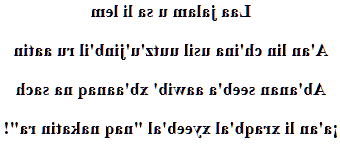Kekchi love poem
Li Lem
Laa jalam u sa li lem
A'an lin ch'ina usil uutz'u'jinb'il ru aatin
Ab'anan seeb'a aawib' xb'aanaq na sach
¡a'an li xraqb'al xyeeb'al "naq nakatin ra"!


→ French poem ←
Q'eqchi' language and legends
Here the translation of my love poem in Kekchi (Kʼekchiʼ, Kekchi', Quecchí, Quecchi', Ketchi', Kekchí, Cacché, Cacche', Alta Verapaz Cobán, Ketchí, Autonym : Q’eqchi’), here in the dialectal variation of Cobán.
This Amerindian language from central Guatemala, is a language of the Mayan language group, close to Quiché.
It has: about 800,000 speakers, in a territory comprising mainly the department of Quiché, but also part of the departments of Petén, Izabal, and Baja Verapaz, to which must be added all the groups emigrated to Belize (district of Toledo), Mexico and El Salvador.
If today, the Kekchis write their language, it has had for a very long time, only the vocation of orality, and the oldest transmitted to the youngest, their stories, myths, tales and legends.
Among the Kekchi, the oldest, have always been the vectors of this history. They occupy a very important place, they must be respected, you have to listen to them, and ask them for advice.
Here is a bit of their oral tradition: “Everything was covered with water! God raised this water to the sky, then created the mountains, on which he left the seeds of everything. This is how everything was created."
This is how these hills, which are their habitat, are so important that everyone needs to know their names. In fact the legend says that these hills are their ancestors; they still exist as humans, but we cannot see them. To break away from the link with the hills would be to break away from the ancestors link and their protection.
"No one knew about corn, and then one day the ancients observed, that wild cats had corn seeds in their droppings, and these grew, when it was not on rocks that they were dropped. It was from the forests of Alta Verapaz that these wild cats brought corn."
"At night and especially whistling at night is to be avoided because it amounts to calling evil spirits."
The Kekchis and their history
The Kekchis are an ethnic group of Mayan origin, which due to their history has been in contact with many other peoples of different cultures ... their culture is surely at least 2,500 years old.
Of the twenty-four indigenous peoples of Guatemala, the Q'eqchí' are in the closest territory from the center of Mayan civilization, Tikal. Before the arrival of the Spaniards, they occupied the territories of Alta Verapaz and Baja Verapaz.
On these territories were discovered, pyramids and stone monuments (Chínama, Ku'k'uch in Chinapetén, Chajkar, Chímax), many jade objects and inscriptions in Mayan glyphs.
It was around 600 BC that the first Q'eqchi' peoples settled on several hills between the Chixoy and Polochic rivers ... they founded the city of Chamá; we can find archaeological remains. Between 300 to 700 AD, we observe new ceremonial areas scattered here and there. Between 700 and 1200, the culture of Pipils, Toltecs and Chichimecas begins to interact with that of Kekchis.
Around 1500, the Q'eqchis lived in communities, in distant houses, and appointed Caciques to lead them. The Cacique of Caciques and the High Priest are number one and two in their social order. Their organization is remarkable on a number of points, whether civilian or military. Everything is rigorously organized, with leaders well chosen by a Supreme Council, formed by great lords (heads of communities).
In 1528, the Spaniards allied with the Tz'utujil of Lake Atitlán, captured the leader of the Q'eqchi and members of his community to reduce them to slavery in the mines. Some manage to escape and return to their mountains. The Spaniards end up leaving Cobán, subject to constant attacks from the Q'eqchis who are joined by the Tz'utujils.
Between 1530 and 1559, it will be total surrender of the Kaqchikel, a surrender which will be doubled by the arrival of missionaries, whose mission was to evangelize and therefore to educate. Quickly, they will regroup the populations, to have groups around them; they will learn their language, and Brother Domingo Vico will even write books in the language. They will create schools, but for a long time these schools will only provide a very basic education.
Famines and epidemics brought by the conquistadors, will decimate in about fifteen years half of the population, which in 1574 will be no more than 3,000 people. The geographical and climatic difficulties will nevertheless be a kind of protection against an influx of settlers; despite these difficulties for agriculture, the region will still be a producer of a little cocoa, sugar cane, and cotton.
Later around 1880, when the cultivation of coffee replaced that of the cochineal, many Germans came to settle in Guatemala. The government will dispossess the Kekchi of their land to give it to them, and submit them as forced laborers ... this is how some will flee to Belize, or in the other places where they are now. Many, will be seen thstill dispossessed of their land due to the extension of plantations.
Marriage by theft, if it is not accepted, can still exist, but as a general rule, one proceeds with a gift, the uncles deciding on the union.
Today families raise a few domestic animals (poultry, pigs etc.), and often just a garden with corn and beans for themselves. They also survive through the work of weaving, carpentry, masonry and all kinds of crafts. The musical instruments that they manufacture, for the most famous, are the harp, the marimba, and the chirimía.
The mineral resources in the region are the copper mines in Kaqipek, between Chamelco and Carchá, and the Oxe'k 'zinc mines in Cahabón and Exmibal in El Estor, and Izabal.